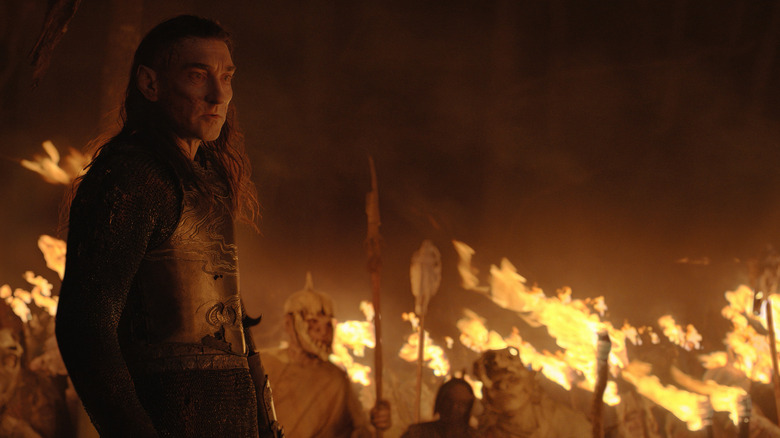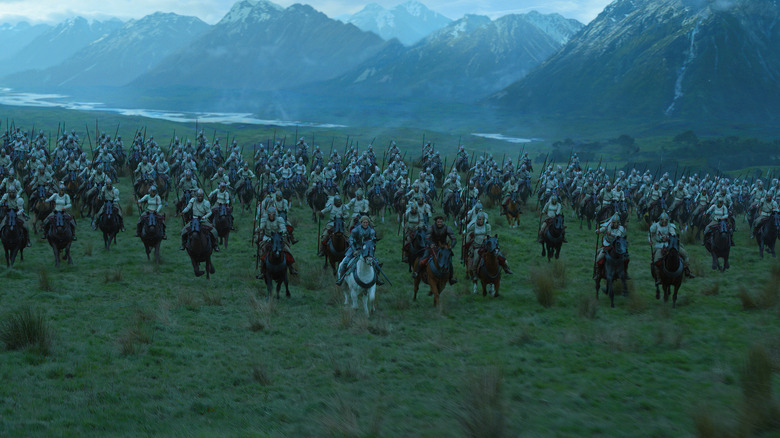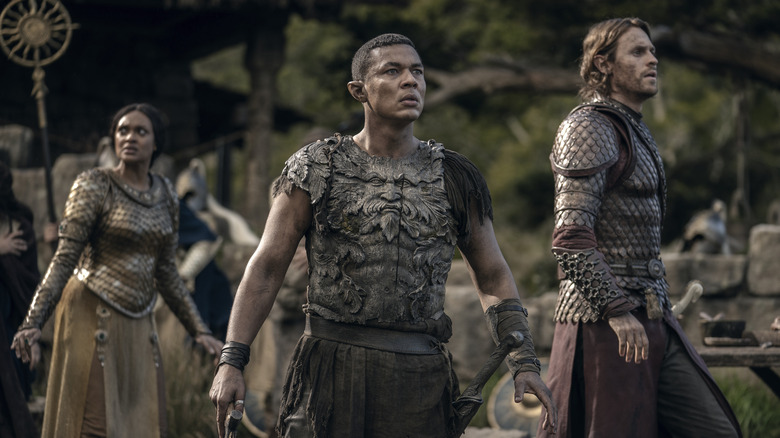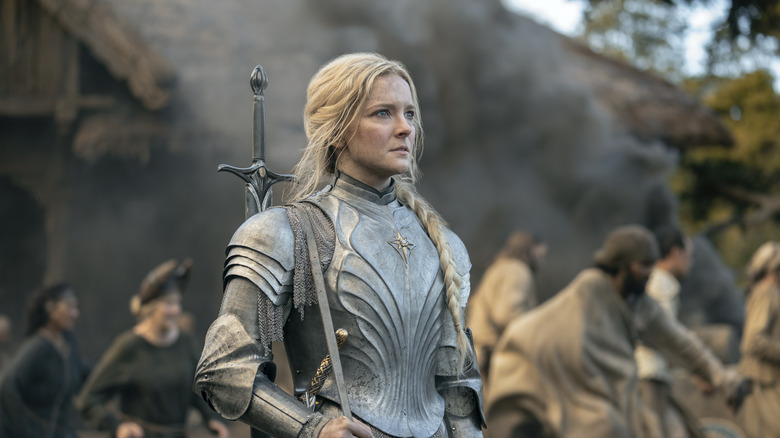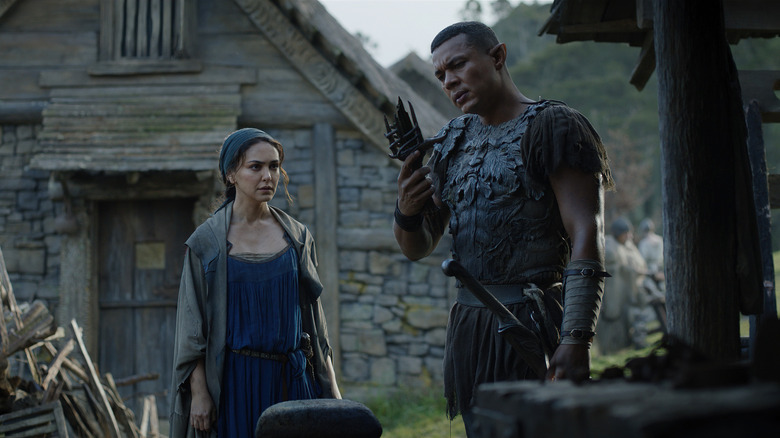The Rings Of Power VFX Producer Talks CG Horses, Orcs, And That Explosive Sequence From Latest Episode [Exclusive Interview]
If you've been watching "The Lord of the Rings: The Rings of Power," you know that the show is expansive in scope, and that we see several major areas in Tolkien's world in full glory on screen. Creating these fictional fantastical places is a group effort of several different departments, not least of which is visual effects. "All of it is a construction, carefully crafted between props, set deck, set, and visual effects," explains the series VFX producer Ron Ames in an exclusive interview with /Film. "They're all one thing."
I talked with Ames about his work on the series, particularly about some sequences we see in the latest episode, "Udûn," that are certainly massive in scope. Read on for that discussion though be warned:
Spoilers through the sixth episode of "The Lord of the Rings: The Rings of Power" lie below!
This interview has been condensed and lightly edited for clarity.
'It isn't the thing that is most dangerous that you do in visual effects'
So there are a lot of battle scenes in the latest episode, I think the biggest battle scenes we've seen to date in the show. How do you approach creating a battle scene like the one we saw at the beginning with the orcs attacking the stronghold in the Southlands, and decide where and how to use VFX?
In this particular case, everything was completely planned, led by [director Charlotte Brändström] and our second unit director, Vic Armstrong, who I love — he is the most famous stuntman in the world. He is Indiana Jones. [Editor's note: Vic Armstrong is, indeed, Indiana Jones — he was Harrison Ford's stunt double for the films.]
Vic is really just this classic British filmmaker and so much fun to be with. That sequence was a straight up classic British horse battle. We broke it down beat by beat, and we did that using super modern techniques from virtual production — we were using virtual cameras with game engine technology to lay it out and storyboard it. And we also used old fashioned methods and just got out there with a camera and through each beat with the stunt people.
How we determine what to use VFX for is not what you would think — it isn't the thing that is most dangerous that you do in visual effects. So when a person fell off a horse or a horse laid down or got up or a chain comes across a bunch of orcs, all of that stuff was real. It was the additional things, the things in the foreground, adding more horses, adding more people, adding more orcs so that we made it more dense.
So we're adding things for safety. For example, you have a horse jumping over a crowd of orcs, the horse would do its jump with the orcs represented with dummies and stuff like that. Then we'd shoot it again with a computerized camera that would do the exact same move of the people on the ground, putting those together, safely making it real.
In this particular case, CG horses, additional CG orcs and Númenóreans, all of those things were added, but all from real stuff. So the horses we scanned and made into CG horses of the real horses that were there on the set. The way I would describe it is handmade, beat by beat.
'There are women orcs there, baby orcs, there are families of orcs'
You mentioned you're creating CG horses and CG orcs. Let's talk about the orcs a little bit — when you're making the CG version of the orcs, how did you approach creating those different types? Because they all look so different on screen.
That was actually Jason Smith, our visual effects supervisor. He also had studied prosthetic make-up as a young man and so he was really interested in all of the creatures. Our approach actually was a storytelling approach. We wanted to say that the orcs are not supernatural beings. They are made, and Tolkien says it, they're made like human beings from men and women. So there are women orcs there, baby orcs, there are families of orcs — we didn't want it to be that they're just evil incarnate. They're a race of beings who have been downtrodden. There's actually a humanity within them but in a very stratified, almost fascist kind of organization where there are leaders and diggers ... it's a very striated society that they come from. So we actually follow those rules and that's how we did it. Each one has a reason for why they're part of that hive.
Do you have any particular favorite moment within "The Rings of Power" where there's a little VFX touch that the general audience might not notice, that you just think really adds to a given scene or sequence?
I would say that this show is the most integrated of any show I've ever worked on. In other words, visual effects and live action are so uniquely connected. Some of the most beautiful connections are in the creation of Númenor, and the ships and all of that, which the art department led by Ramsey Avery did a magnificent job of creating sets.
But how much can you actually build? I mean it was huge — it was like a couple of blocks, but the extensions in there I think are seamless. We were really trying to make it an idealized world. And so I think where the set ends and our extensions continue where the water is and where real water is almost impossible to see.
'It's the integration that's the art'
This is a very specific question about Númenor — there's a scene at the docks of Númenor in episode 105 and they're loading to leave, to go to Middle-earth. And in the background, you see a horse being lifted up to be put on the ship. I just love that detail because obviously the horses have to get on the ship, but you just never really see that even in the background of shows, that I've noticed.
Oh my god, I remember that moment. That is four shots. So the dock itself was real, the water was real, the little boats are real, but the ships themselves are CG, and everything is extended. The horses on the dock are real, but that horse that's being lifted up, that was a detail we added because we thought, "Oh my god, how do they get the horses on there? They're going to have to have a crane. Let's include it." I'm so glad you saw that because I love that shot. It looks so real.
And the horse you can see looks kind of resigned to it.
Thank you so much. All of that detail in every one of those shots we asked, "What was the performance of the horse?" And that's true in fact in the battle scene as well. Our goal was always to be a slight of hand, not to be tricky about it, but to lead the eye to the most important part of the storytelling so that you don't have to be uncomfortable with the visual effects.
People say to me all the time, "That's real. That's not real." It's like, "No, I'm sorry. None of it's real." All of it is a construction, carefully crafted between props, set deck, set, and visual effects. They're all one thing. This is modern filmmaking. And to look at it one way or another, there's a disconnect. It's the integration that's the art.
'It's just magnificent, almost like an atomic bomb explosion'
I have to talk about the very end of the episode 106 with the volcano, the water rushing through and the smoke just coming towards Galadriel. How did you create that whole sequence, with the water rushing through the tunnels and then falling into the pit of the volcano?
That may be my favorite sequence of the entire season. I love that sequence. It was designed by Jason Smith, our visual effects supervisor and we used Weta, ILM, and Rising Sun in Australia to do that. It was a combination of those companies and moving seamlessly between those shots.
It was a really complex plan — how do you tell the story of what is really a cataclysmic environmental challenge? So what we did was we started with the real — we looked at photographs and movies, went back to Pompeii, looked at what happened, and read about what it really looks like, what really happens. Could this physically happen? And the answer is yes, it could. Again, how do we tie that all together? So we used photography — the actual architecture of the cliffside and all of that was real. We went to the south islands and shot photographs of the real place where the tower was and the waterfall and everything else was based on real photographs.
For the water underground, we had underground sets and we photographed and scanned those. I am actually surprised by how beautiful the water going through the tunnels looks — it does not look phony at all. And then as the cold water rushes into the interior of the volcano creating a temperature differential, it's just magnificent, almost like an atomic bomb explosion. The other part of the storytelling I love is that throughout the whole show, you see that mountain in the background, not knowing that it is going to eventually pay itself off. We never make a big deal of it, but you see it back there and then eventually it has a large part in our story.
New episodes of "The Lord of the Rings: The Rings of Power" drop on Thursday nights on Prime Video.
